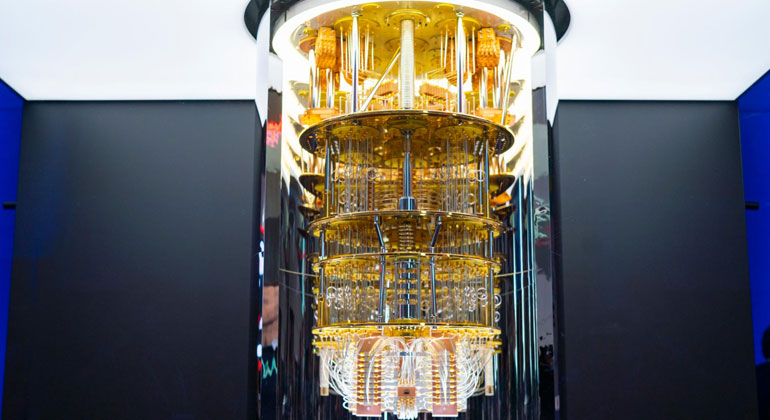Increasing battery and fuel cell power with quantum computing
DLR is using a quantum computer to simulate electrochemical processes in batteries and fuel cells. Focus: Energy, digitalisation, quantum computing, energy storage, energy efficiency, hydrogen.
The German Aerospace Center (Deutsches Zentrum für Luft- und Raumfahrt; DLR) is conducting research into new materials for more powerful batteries and fuel cells. DLR scientists are now using a quantum computer to simulate electrochemical processes within energy storage systems. This makes it possible to design the materials used in such a way that the performance and energy density of batteries and fuel cells increase significantly.
The special thing about QuESt (Quantencomputer Materialdesign für elektrochemische Energiespeicher und -wandler mit innovativen Simulationstechniken; Quantum computer material design for electrochemical energy storage systems and converters with innovative simulation technology) is that it uses quantum computers for a highly application-oriented task in materials research. QuESt thus combines both fundamental and applied research in the field of energy storage.
Quantum chemistry determines power and energy density
Above all else, electromobility requires small, lightweight energy storage systems with high capacities and performance. The material and structure of the electrodes are key factors, as they affect the energy density and the voltage. With optimised materials, it is also possible to prevent decomposition processes and thus prolong the service life of batteries and fuel cells.
When electricity flows through a battery or fuel cell, ions within it travel from one electrode to the other. Ions gain or lose an electron at the surfaces of the electrodes. “The processes can be described with precision with the help of quantum physics. The electrons essentially change their quantum mechanical state. We can simulate these energy states using a quantum computer. This allows us to calculate how much energy is in the electrochemical reactions and how fast these are occurring,” says Birger Horstmann, Head of the Theory of Electrochemical Systems Group at the DLR Institute of Engineering Thermodynamics.
In these simulations, the DLR scientists compare the quantum chemical interactions that occur with various novel materials and electrode structures. They are aiming to achieve the highest possible chemical bonding energies for electrons in batteries. In fuel cells, hydrogen and oxygen should react with each other as efficiently as possible.
Targeted material design of battery electrodes with quantum computers
The QuESt project is seeing the DLR Institute of Engineering Thermodynamics, Institute of Quantum Technologies and Institute for Software Technology, together with the Fraunhofer Institute for Mechanics of Materials (Fraunhofer-Institut für Werkstoffmechanik; IWM), breaking new ground in terms of materials design for energy storage systems. With the help of a quantum computer, the researchers study how atoms and molecules interact with the different electrode materials in batteries and fuel cells. “Quantum simulations have the potential to revolutionise computer-aided materials design. We want to use them to optimise the chemical compositions of the electrodes and their microscopic structure,” says Horstmann. “A quantum computer enables us to study the quantum-chemical processes occurring at the electrodes of batteries and fuel cells with the utmost precision. We are conducting research to find out the best way of programming our quantum computer for that purpose,” says Sabine Wölk of the DLR Institute of Quantum Technologies.
The QuESt project is using the Fraunhofer Society’s IBM quantum computer, which is funded by the German Federal State of Baden-Württemberg. This uses very small, superconductive coils, referred to as Josephson junctions, as qubits.
Quantum simulation of energy storage systems has applications in other fields
The quantum algorithms devised over the course of the QuESt project also serve as a starting point for future quantum software. The underlying algorithms and steps towards solutions could be carried across to other problems in quantum physics. Findings arising from the simulation of energy storage devices as quantum many-body systems are also set to be applied to other areas of research, such as medicine and the chemical industry.
The Baden-Württemberg Ministry of Economic Affairs, Labour and Housing is funding the QuESt project, which was launched in January 2021, with 1.5 million euro over two years. In addition to the DLR institutes and Fraunhofer IWM, the companies Robert Bosch GmbH and Mercedes-Benz Research and Development North America Inc. are also involved in the project as associated partners.
QuESt combines interdisciplinary expertise in quantum technology and battery and fuel cell research at the Helmholtz Institute Ulm (HIU) and the University of Ulm. The HIU was founded in 2011 by the Karlsruhe Institute of Technology (KIT), with the University of Ulm, DLR and the Center for Solar Energy and Hydrogen Research (Zentrum für Sonnenenergie- und Wasserstoff-Forschung Baden-Württemberg; ZSW) as associated partners.
Quantum computers – more than 0s and 1s
A quantum computer works differently to a normal computer. Its quantum bits, or qubits for short, follow the laws of quantum physics, which describe processes at an atomic level. The bits of a classic computer know only two states – 0 and 1. Qubits, by contrast, can assume an infinite number of intermediate values. This opens the way for new algorithms that are not possible on conventional computers. Electrons, atoms, ions and photons are all physical manifestations of qubits.
Source
German Aerospace Center (Deutsches Zentrum für Luft- und Raumfahrt; DLR) 2021








